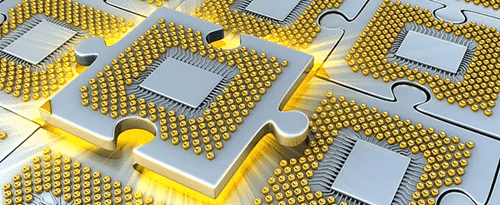With the PCB board design, along with the rapid increase in frequency, the inconsistency between many interference other than the design of the low frequency PCB board, increase in the frequency, miniaturization of the PCB board and cost reduction becomes more noticeable.
These interferences are becoming more complex and complex. Current research concludes that there are four main types of interference: voltage noise, transmission line interference, coupling, and electromagnetic interference. In this paper, we analyze various interference problems of high frequency circuit board and propose an effective solution by combining the practices.
In the high-frequency circuit of power supply noise, the noise of the power supply is particularly significant for high-frequency signals. Therefore, the power supply is first required to be low noise. Here, clean ground and clean power are just as important, why? Obviously, the power supply has a certain impedance, and the impedance is distributed over the entire power supply, so the noise is also superimposed on the power supply.
Then we should reduce the impedance of the power supply as much as possible, so it is best to have a proprietary power plane and ground plane. In high-frequency circuit design, the power supply is designed in layers, which is much better in most cases than in the form of a bus, so that the loop can always follow the path with the least impedance.
In addition, the power board has to provide a signal loop for all generated and received signals on the PCB, which minimizes the signal loop and reduces noise, which is often overlooked by low-frequency circuit designers.

Power Supply Characteristics
There are several ways to eliminate power supply noise in PCB design.
Pay attention to the through hole on the plate: the through hole makes it necessary to etch the opening on the power supply layer to leave a space for the through hole to pass. If the power supply layer is too large, it will affect the signal loop, the signal will be forced to bypass, the loop area will increase, and the noise will increase. At the same time, if some signal lines are concentrated near the opening, sharing this loop, the common impedance will cause crosstalk.
The cable requires enough ground: each signal needs its own proprietary signal loop, and the loop area of the signal and loop is as small as possible, that is, the signal is parallel to the loop.
Analog and digital power supplies should be separated: high-frequency devices are generally very sensitive to digital noise, so the two should be separated and connected together at the entrance of the power supply. If the signal crosses both analog and digital, it can be at the signal crossing. Place a loop to reduce the loop area.
Place the power cord on the side of the signal line
The transmission line only has two kinds of transmission lines in the PCB: strip line and microwave line. The biggest problem of the transmission line is reflection. The reflection will cause many problems. For example, the load signal will be the superposition of the original signal and the echo signal, and the signal analysis will be increased. Difficulty; reflection causes return loss (return loss), and its influence on the signal is as serious as the effect of additive noise interference:
The signal reflected back to the signal source will increase the system noise, making it more difficult for the receiver to noise and The signals are separated; any reflected signal will basically degrade the signal quality, which will change the shape of the input signal. In principle, the solution is mainly impedance matching (for example, the interconnection impedance should match the impedance of the system), but sometimes the calculation of the impedance is cumbersome.

Ways to eliminate transmission line interference: Do not use pile lines. Because any pile line is a source of noise. If the pile line is short, it can be terminated at the end of the transmission line; if the pile line is long, the main transmission line will be the source, which will cause a large reflection, which complicates the problem and is not recommended.
Coupling:
Common Impedance Coupling: This is a common coupling channel. That is, interference sources and faulty devices often share specific conductors (loop voltage, bus, common ground, etc.). Field common mode coupling produces the common mode voltage in the loop formed by the noise circuit and the common reference plane.
If the magnetic field is dominant, the value of the common mode voltage generated in the series-connected loop is Vcm=-(ΔB/Δt)* area (where ΔB = the amount of change in magnetic induction). If it is an electromagnetic field, it is known. Its electric field value, its induced voltage: Vcm = (L * h * F * E) / 48, the formula is applicable to L (m) = 150MHz or less, beyond this limit, the calculation of the maximum induced voltage can be simplified as: Vcm = 2*h*E.
Differential mode field coupling: means that direct radiation is received by the wire pair or the leads on the circuit board and its circuit. If it is as close as possible to the two wires. This coupling is greatly reduced, so the two wires can be twisted together to reduce interference.
Line-to-line coupling allows any line to be equal to undesired coupling between parallel circuits, which can severely compromise system performance. Its types can be divided into capacitive crosstalk and inductive crosstalk.
The former is because the parasitic capacitance between the lines causes the noise on the noise source to be coupled to the noise receiving line by the injection of current; the latter can be thought of as the coupling of the signal between the primary and secondary of an unwanted parasitic transformer.
The magnitude of the inductive crosstalk depends on the proximity of the two loops and the size of the loop area, as well as the impedance of the affected load.
Power line coupling: When the AC or DC power line is subjected to electromagnetic interference, the power line transmission these interferences to other devices. There are several ways to eliminate crosstalk in PCB design: the size of both crosstalk increases with the increase of load impedance, so the signal line sensitive to interference caused by crosstalk should be properly transmission.
Increasing the distance between signal lines as much as possible can effectively reduce capacitive crosstalk. Ground layer management is performed, and the spacing between the wirings is made (for example, the active signal lines and the ground lines are isolated, especially between the signal lines where the state jumps and the ground is further spaced) and the lead inductance is reduced.
Inserting a ground line between adjacent signal lines can also effectively reduce capacitive crosstalk, which requires access to the ground plane every 1/4 wavelength.

For inductive crosstalk, the loop area should be minimized and eliminated if possible. Avoid signal sharing loops. Focus on signal integrity: Designers need to implement terminations during the soldering process to address signal integrity.
Designers using this approach can focus on shielding the microstrip length of the copper foil for good signal integrity. For systems that use dense connectors in the communication structure, the designer can terminate with a single PCB.
Electromagnetic Interference As speed increases, EMI will become more and more serious and manifest itself in many aspects (such as electromagnetic interference at the interconnection). High-speed devices are particularly sensitive to this, and it will therefore receive high-speed false signals. Low-speed devices ignore such false signals.
There are several ways to eliminate electromagnetic interference in PCB design:
Reduce the loop: each loop is equivalent to one antenna, so we need to minimize the number of loops, the area of the loop and the antenna effect of the loop. Make sure that the signal has only one loop path at any two points, avoiding artificial loops and using the power plane as much as possible.
Filtering: Filtering can be used on the power line and on the signal line to reduce EMI. There are three methods: decoupling capacitors, EMI filters, and magnetic components. The EMI filter is shown in Figure .
Due to the length of the problem and the many articles on the discussion of shielding, we will not specifically describe the speed of reducing the high-frequency devices as much as possible. Increasing the dielectric constant of the PCB board can prevent the high-frequency part of the transmission line close to the board from radiating outward.
Increasing the thickness of the PCB board and minimizing the thickness of the microstrip line can prevent the overflow of the electromagnetic line and also prevent radiation.
In this discussion, we can summarize that in high-frequency PCB design, we should follow the following principles: the unity of power and ground, stable. Careful wiring and proper termination eliminates reflections. Careful consideration of wiring and proper termination can reduce capacitive and inductive crosstalk. Noise suppression is required to meet EMC requirements.

 My Message
My Message
 Suggestions
Suggestions












